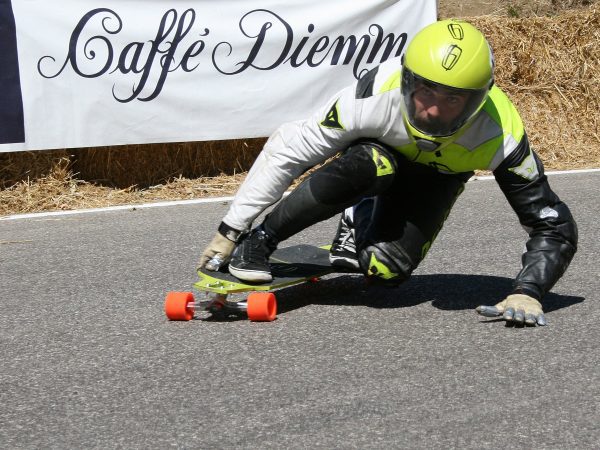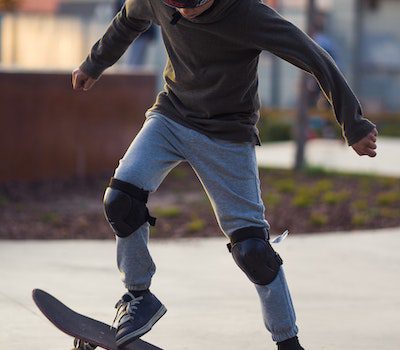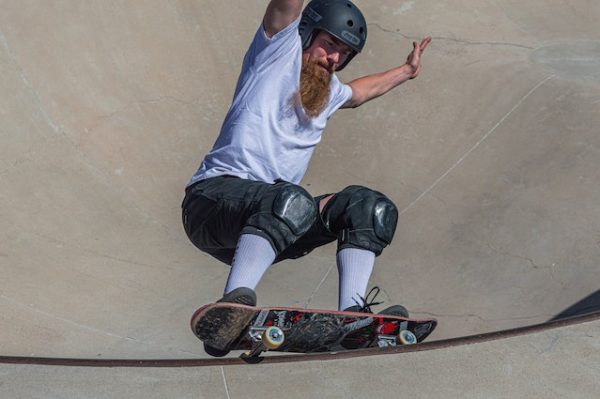Skateboarding is not just a sport; it’s a way of life. The thrill of gliding through the streets, conquering gravity-defying skateboard tricks, and feeling the rush of wind against your face is unmatched. However, every epic skateboarding adventure begins with one fundamental aspect: how to choose the right gear. Let’s discuss this to learn more.

Whether you’re a newbie eager to embark on your first skateboard journey or an experienced skater seeking to upgrade your equipment, making informed choices about your skateboarding gear is vital. With an overwhelming array of decks, trucks, wheels, bearings, and safety skateboarding gear, it’s easy to get lost in the options.
Fear not, for this comprehensive guide is your compass to navigate the world of skateboarding gear. We will walk you through the essential considerations for selecting the perfect skateboard deck, trucks, wheels, bearings, and protective equipment tailored to your style and skill level.
Join us as we unveil the secrets to optimizing your skateboard experience. From choosing the right skateboard deck size for your tricks to choosing the ideal wheels for your preferred terrain, we’ve got you covered. Get ready to elevate your game, explore new possibilities, and stay safe on your journey to skateboarding greatness.
So, grab your helmets, lace up your skate shoes, and dive into this guide to discover the art of selecting the finest skateboard gear for an unforgettable ride!
Choosing Skateboarding Gear
Key Takeaways
- Choose a skateboard deck size that matches your style and skill level.
- Invest in high-quality trucks and bearings for better stability and control.
- Consider the size and hardness of the wheels based on your preferred type of skateboarding.
- Prioritize safety by wearing a helmet, knee pads, elbow pads, and wrist guards.
- Choose skateboarding-specific shoes with flat soles and a good grip.
- Look for skateboarding gear with reinforced construction and durable materials for longevity.
- Choose the right balance between grip and comfort in the grip tape.
- Regularly maintain and care for your skateboarding gear to extend its lifespan.
- Stick to reputable skateboarding gear brands known for their quality and reliability.
- Embrace the joy of self-expression and creativity in skateboarding.
Introduction
Choosing the right skateboard gear is crucial for both safety and performance. Whether you’re a beginner or a seasoned skater, having the appropriate equipment can significantly impact your overall experience. Here are some essential tips to help you make the right choice when selecting skateboard gear:

Decks
The skateboard deck is the main board on which you stand. Choose a deck size that suits your style and skill level. Smaller decks (7.5″ to 8″) are better for street skating and technical tricks, while larger decks (8.25″ and above) are more stable and suitable for ramp or vert skating. For beginners, a mid-size deck around 8″ is a good starting point.
Trucks
Trucks are the metal T-shaped components that attach the wheels to the deck. The width of your trucks should match the width of your deck. High-quality trucks offer better stability and control. Look for reputable brands that match your deck size.
Wheels
Skateboard wheels come in various sizes and hardness levels (measured in a durometer). Smaller and harder wheels (92A to 99A) are better for street skating and tricks, while larger and softer wheels (78A to 87A) provide a smoother ride and are ideal for cruising and vert skating.
Bearings
Bearings enable the wheels to spin smoothly. ABEC ratings indicate the precision of the bearings, but for skateboards, ABEC 5 or higher is sufficient. Ceramic bearings are more durable and offer a smoother ride, but they can be pricier.
Grip Tape
Grip tape is the rough, sandpaper-like surface on the top of the deck. Choose a grip tape that matches your deck size and provides ample grip for your shoes. Custom grip tape designs are available if aesthetics are essential to you.
Safety Equipment
Always prioritize safety when skateboarding. Invest in a good-quality helmet that fits properly and meets safety standards. Knee pads, elbow pads, and wrist guards are also important, especially for beginners and those attempting new tricks.
Shoes
Select skateboarding-specific shoes with flat and grippy soles for better board control. Skate shoes are designed to withstand wear and tear from grip tape and provide ankle support.
Budget And Quality
Consider your budget while shopping for gear, but don’t compromise on quality. Higher-quality gear lasts longer and offers better performance, saving you money in the long run.
Brand Reputation
Stick to reputable skateboarding brands known for their quality and durability. Brands like Vans, Nike SB, Santa Cruz, Element, and Independent are well-regarded in the skateboard community.
Try Before Buying
Visit a local skate shop to try different skateboards and gear if possible. Testing the equipment can give you a better sense of what suits your preferences and style.
Online Reviews
If you’re buying online, read customer reviews and watch video reviews to gain insights into the performance and durability of the gear you’re interested in.
Remember, skateboarding is a highly personal sport, and your gear choices may evolve as you progress. Don’t be afraid to experiment and choose what works best for you. Prioritize safety, invest in quality gear, and, most importantly, have fun on your skateboard!
Selection
When selecting skating equipment, two crucial aspects that should never be overlooked are comfort and durability. Skating is a physically demanding activity that can stress your body and equipment, making these considerations essential for a smooth and enjoyable skateboard experience. Here are some key points to keep in mind:

- Comfortable Deck Shape: The shape and concave of the skateboarding deck influence how comfortable it feels under your feet. Experiment with different deck shapes and concave profiles to choose one that suits your stance and riding style. A comfortable deck will allow you to maintain better control and easily perform tricks.
- Cushioned Grip Tape: The grip tape on the skateboard deck should provide adequate traction without causing discomfort to your shoes. Too coarse grip tape might be harsh on your feet, especially during longer rides, so choosing the right balance between grip and comfort is essential.
- Ergonomic Footwear: Invest in skateboard-specific shoes with cushioning, ankle support, and a flat sole. Proper footwear enhances comfort and protects your feet from impact and grip tape abrasion.
- Padding and Protection: Safety skateboard gear such as knee pads, elbow pads, and wrist guards should be protective and comfortable to wear for extended periods. Look for gear with breathable materials and adjustable straps to ensure a snug fit.
- Durable Construction: Opt for skateboard decks made from high-quality materials like maple wood, as they offer better durability and resilience against wear and tear. Stronger decks are less likely to snap or break, especially during intense tricks and stunts.
- Reinforced Trucks and Bearings: Sturdy skateboarding trucks and high-quality bearings can significantly impact the durability and performance of your skateboard. Look for trucks with reinforced metal components and bearings with seals or shields to protect against dirt and debris.
- Abrasion-Resistant Wheels: Skateboard wheels wear often, especially during slides and tricks. Choose wheels made from durable urethane material with a higher durometer rating for improved longevity and resistance to flat spots.
- Stitched Pads and Gear: If you’re using protective skateboarding gear, ensure it’s made with durable stitching and robust materials. Well-constructed pads and gear are less likely to tear or wear out quickly, providing long-lasting protection.
- Maintenance: To extend the life of your gear, perform regular maintenance. Keep your bearings clean and lubricated, tighten loose bolts, and replace worn-out parts promptly.
- Reputation: Trustworthy skateboarding brands often invest in research and development to create gear that combines comfort and durability. Look for well-established brands with a track record of producing reliable products.
Comfort and durability are essential elements that affect your performance and overall skateboarding enjoyment. By paying attention to these considerations and investing in high-quality gear, you’ll be better equipped to pursue your skateboarding passion safely and confidently. Remember, caring for your gear will extend its lifespan and contribute to a more sustainable approach to skateboards. Happy skating!
Conclusion
Consider how to choose your skateboarding gear to enhance your experience. Selecting a complete skateboard with durable components, such as sturdy trucks for street skateboarding and appropriate bearings for ramp skating is essential. Refine your style by mastering tricks, understanding your preferred board shape, and connecting with other skaters.
Choosing skateboarding gear that fits well and offers optimal performance can significantly improve your progression. Choose comfortable shoes and supportive protective gear, including riser pads, to skate confidently and push your limits. Durability is crucial for gear longevity, especially when performing tricks and riding in various environments. Always prioritize safety by wearing essential protective gear like helmets, knee pads, elbow pads, and wrist guards, regardless of your skill level.
How To Choose The Best Skateboarding Gear
Frequently Asked Questions (FAQs)
What Is Proper Helmet Size?
What is the Right Equipment?
How Do You Select A Skateboard Helmet?
Choosing a skateboard helmet is essential for ensuring your safety while skateboarding.
- Look for a “skate helmet” specifically designed for skateboarding protection.
- Measure your head size using a measuring tape above the eyebrows and around the widest part of your head. Use this measurement to find the right size on the helmet’s chart.
- Ensure the helmet sits level on your head, covering your forehead, and the straps form a “V” shape around your ears.
- Adjust the chin strap for a snug fit, allowing one to two fingers between your chin and the strap.
- Try the helmet on with your skateboard gear to check the overall fit.
- Choose a helmet with durability and protection, considering nine-ply or seven-ply construction factors.
How Do You Select A Skateboard Deck Size?
Choosing the right skateboard size is crucial for your riding comfort and performance.
- Consider your height, weight, and shoe size to determine the right skateboard width. Wider boards offer stability, while narrower ones provide easier maneuverability. For beginners, a width between 7.5 and 8.25 inches is ideal.
- While the width is more crucial, the length of the skateboard, typically between 31 and 33 inches, also affects its feel. A longer board may be better for high speeds and ramps, whereas a shorter board offers more control for street tricks.
- The most important factor in choosing a skateboard size is how it feels under your feet. Stand on the deck near the trucks to ensure your toes and heels don’t hang over.
- Ensure the skateboard’s slide or pivot aligns with the deck’s edge for optimal protection and functionality.
- Experiment with different sizes and shapes based on your skateboarding style until you find the one that best fits your preferences and techniques.
How Do You Measure A Skateboarding Protective Gear?
Measuring for skate protective gear involves considering several factors.
- Knee and Elbow Pads: Wrap measuring tape around the joint and adjust the straps for a snug fit that isn’t too tight. If you are uncertain about the size, refer to the manufacturer’s sizing chart.
- Skateboard Helmets: Ensure the helmet fits securely, covers the forehead, and sits level on your head.
- Skating Style and Preferences: Choose protective gear suited to your style; more substantial gear may be needed for aggressive skateboarding or vert skating.
- Additional Activities: If you also bike, check if your bike pads are suitable for skateboarding.
- Weight Considerations: Heavier riders might prefer more substantial padding for enhanced protection.
- Coverage and Fit: Ensure your protective gear adequately covers critical areas such as knees, elbows, and wrists and fits securely to provide effective skateboarding protection.
What Does 8.25 Mean On A Skateboard?
The number 8.25 represents the width of the skateboard deck in inches. Different widths suit various riding styles and preferences:
- An 8.25-inch width is a mid-sized board suitable for a broad range of skaters, balancing versatility and stability.
- Narrower boards (7.5 to 8 inches) are ideal for street or technical skateboarding due to better maneuverability.
- Wider boards (8.25 to 8.5 inches) are preferred for transition skating or vert, offering more stability for riders with larger feet.
The right board size depends on your shoe size, skating style, and preference. Finding a board that feels comfortable and allows easy tricks to be performed. Experimenting with different sizes can help you determine the best fit for your skateboarding style.
How To Use A Helmet For Skateboarding?
While any helmet is better than no helmet, it’s essential to use one specifically designed for skating for the best protection. Skateboard helmets are designed to withstand the impact forces, and potential falls common in skateboarding. Compared to other types of helmets, skateboard helmets provide more coverage and protection to the back of the head.
Using a helmet designed for skateboarding ensures that it meets safety standards and is appropriate for the specific risks and impacts associated with skateboarding. Ensure the helmet fits properly and sits level on your head with the chin strap securely fastened. When properly fitted, the helmet should sit low on your forehead, just above your eyebrows, and your fingers should not be able to fit between the strap and your chin. Always prioritize safety and use the right equipment, with the helmet securely fitted to protect your head and “fingertips” while skateboarding.
How Many Hits Can A Helmet Take?
A helmet’s lifespan depends on the severity and construction of the impact. Helmets are generally built for one significant impact or several minor ones. After a significant impact, replace the helmet immediately, even without visible damage, as its protective ability might be compromised. Always follow the manufacturer’s replacement guidelines and regularly check for any signs of damage. Replace the helmet after any accident or major impact, regardless of visible damage, to ensure your safety.
How To Choose A Skateboard For A Girl?
When choosing a skateboard for a girl, consider her age, size, and skill level. Opt for a skateboard deck with a width that suits her shoe size and age. A narrower deck of around 7.5 to 8 inches may be more suitable for younger or smaller girls, while older or taller girls may prefer a wider deck of around 8.0 to 8.25 inches.
How To Start As A Beginner Skateboarder?
To start as a beginner skateboarder, consider these steps:
- Choose the Right Deck: Opt for a skateboard with a mellow, concave shape, which offers stability for beginners. More experienced skaters might prefer a steeper concave for better control during tricks.
- Select Suitable Components: Complete the setup with appropriate trucks, wheels, bearings, and grip tape. When choosing these components, consider the rider’s weight.
- Pick the Right Wheels: Choose wheels with a durometer suitable for the terrain she will be skating on.
A proper skateboard should comfortably fit the rider, match her skill level, and support a safe and enjoyable skating experience.
Last Updated on June 9, 2024 by Lisette Lao
DISCLAIMER (IMPORTANT): This information (including all text, images, audio, or other formats on FamilyHype.com) is not intended to be a substitute for informed professional advice, diagnosis, endorsement or treatment. You should not take any action or avoid taking action without consulting a qualified professional. Always seek the advice of your physician or other qualified health provider with any questions about medical conditions. Do not disregard professional medical advice or delay seeking advice or treatment because of something you have read here a FamilyHype.com.